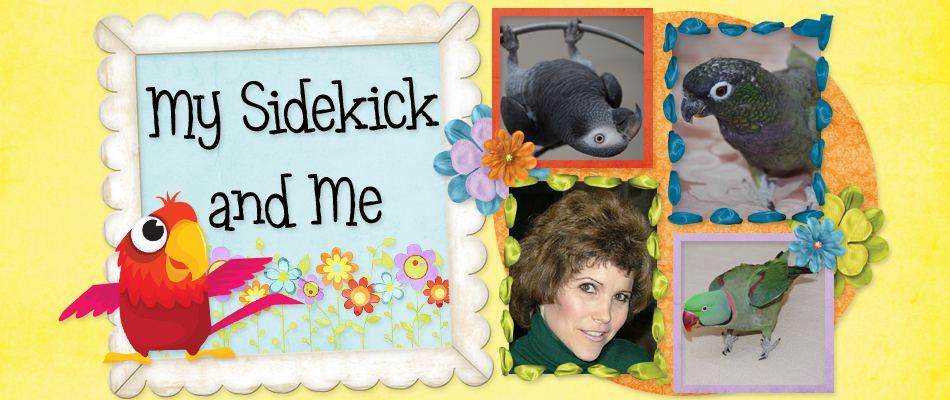I found this on youtube. I had so much fun watching it that I forgot to count score but I'm sure the African Grey won!
Saturday, August 29, 2009
It's Parrot Basketball!
Sunday, August 23, 2009
Snowball Is At It Again
Yep, the beautiful dancing cockatoo who has graced the stage of the Ellen Degeneres Show and the front page of the Times newspaper is showing more of her stuff. Snowball belongs to Irena Schulz of Bird Lovers Only Rescue Service, a non-profit donation based rescue which takes in unwanted, neglected, abused birds and birds with disabilities. Her website is located at http://www.birdloversonly.org.
If you'd like to learn more about Snowball's story, click here.
However, please DO NOT watch or read about Snowball, and think a cockatoo is for you. Cockatoos are definitely not a bird to adopt on impulse - which is why so many of them end up in rescues. As with any pet, do you research before bringing one home. Here is an article about cockatoos as pets. 
Wednesday, August 12, 2009
New Research Challenges Dominance Based Training Techniques For Dogs
ScienceDaily (2009-05-25) -- A new study shows how the behavior of dogs has been misunderstood for generations: in fact using misplaced ideas about dog behavior and training is likely to cause rather than cure unwanted behavior. The findings challenge many of the dominance related interpretations of behavior and training techniques suggested by current TV dog trainers.
http://www.sciencedaily.com/releases/2009/05/090521112711.htm#
Sunday, August 9, 2009
But What's REALLY Going On When Your Pet Is Suddenly Phobic?

A couple of years ago I devoted one of my Hyde Park Living pet columns to talking about sudden fear exhibited by pets. I thought I would share it on my blog to help more people. Below is an exerpt...
With birds especially, I’ve often heard people talk of their pet’s sudden neurotic, phobic behaviors. Out of the blue, for no apparent reason, their loving companion will scream, lunge or try to escape the hands that up until that moment had only been associated with positive things.
I know about this, unfortunately, from firsthand knowledge. My loving Barnaby Timneh African Grey, who normally would be very happy spending his entire day with his face pressed against mine (of course it would have to be with the occasional play break), would suddenly ‘out of the blue’ panic when he stepped onto my arm. He’d scream with horror in his voice, breathe heavily, and then take off. If you’ve ever experienced the unconditional love of an animal, you can probably understand it is completely heartbreaking when you are thrust into the portrayal of some evil monster – and you don’t even know why.
Each time it would happen with Barnaby, I’d have to go through a systematic desensitization plan to help him overcome his anxiety. Because we have a long history of trust, we were able to work through this fairly quickly, but my training taught me there had to be a reason for this reoccurring behavior. And there also had to be a way of eliminating or minimizing the frequency of it. Behavior, I know, doesn’t ever happen willy nilly. It is always triggered by something in the environment. And the consequences of that behavior are what either maintains, builds or extinguishes it.
Hmm. Actually it became fairly easy to figure out once I put on my behavior analysis hat.
There is a window in the birds’ room that faces the street. On sunny days, when a car drives past, the light that reflects from the metal and glass makes a brilliant pass from one wall to the next. A pretty scary demon to a Timneh teddy bear no longer than a ruler. If my neighbor parks her car in a certain spot at a certain time of day and Barnaby happens to be way up high, that same evil light hovers. Each time that Barnaby jumped on my arm, only to be terrified, that same ‘trigger’ light just happened to be coming from the street.
My mentor and teacher, Dr. Susan Friedman – a respected psychologist and behaviorist - helped me to understand. Purely based on my poor timing, in Barnaby’s mind, I got associated with the light. And that was not a good thing to be paired with.
Barnaby had two types of behaviors going on. One was an automatic, involuntary response to a bright light (panic scream, escape). In scientific terminology, this is called an unconditioned or respondent behavior because it wasn’t something that Barnaby learned in the way that he came to know stepping up generally meant only good things would follow. On the other hand, his stepping up behavior is most definitely learned. Scientists call that operant learning.
Now, think of the use of a clicker. The clicker in and of itself is meaningless to an animal. It only acquires value to that animal when a good trainer repeatedly pairs the sound with a treat. Then the click acquires reinforcing value.
This same type of association was going on with Barnaby, only it was a negative one. Being on my arm – something that had always given him positive reinforcement in the past – when the light (remember, something that causes an unconditioned fear response) came through the window, was being paired with that fear response. Just as the words ‘good boy’ have become associated with safflower seeds, his being on my arm had become associated with that awful light.
Once this became clear, working toward a solution really wasn’t that difficult. What I learned from Susan (and so many great people on Susan’s international parrot behavior listserve) is how to modify Barnaby’s environment so as to set him up for success. When I’m working from home, I try to remember to close their shade at a certain time. But if the shade is up, and there is that dangerous light outside (at least in his eyes), I absolutely will not pick him up. Instead, he’s learned to go inside his cage at that time. That one small adjustment has meant the difference between a pet who became instantly phobic of me – on a more frequent basis – to one who hasn’t exhibited those behaviors once since I figured it all out. So, it really wasn’t just some irrational fear after all.
This isn’t to say that something else in the future may pop up, that will cause that same fear response. Barnaby is a living being, and, as life goes, behaviors evolve all the time to adapt to the environment. But next time, I’m going to be better equipped to send those awful monsters packing so Barnaby can just focus on having fun.
Thursday, August 6, 2009
Meet Oscar, One Happy American Cocker Spaniel

By the way, I met Helen at the International Association for Avian Educators and Trainers Conference that was held in Cincinnati earlier this year. She is a trainer at the Seneca Park Zoo in Rochester, New York. Maybe in the future I'll post some pictures of her with her co-workers.











